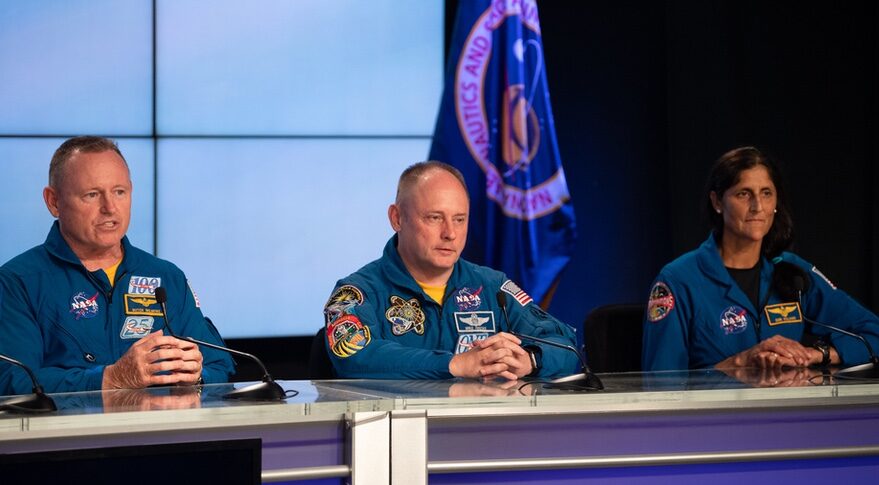
NASA plans to make Starliner crew assignments this summer (Image Credit: Space News)
WASHINGTON — As Boeing’s CST-100 Starliner prepares to return from its brief trip to the International Space Station, NASA officials say they’ll wait until this summer to determine the schedule for the vehicle’s first crewed flight and the astronauts who will fly it.
NASA said May 23 it would proceed with plans to have Starliner return to earth May 25, six days after its launch on the Orbital Flight Test (OFT) 2 uncrewed mission. The astronauts on the ISS will close Starliner’s hatch May 24, with undocking about 24 hours later at 2:36 p.m. Eastern May 25. That would allow Starliner to land at White Sands Space Harbor in New Mexico at 6:49 p.m. Eastern that day.
In prelaunch briefings, NASA officials declined to set a date for the next test flight, the Crew Flight Test (CFT), which will carry people for the first time. The schedule, they said, will depend on any modifications to the spacecraft that emerged from OFT-2. The current mission has experienced several minor issues with malfunctioning thrusters and cooling systems, none serious enough to alter the mission.
“One of the things we have to do is do this mission,” Kathy Lueders, NASA associate administrator for space operations, said of OFT-2 at a May 18 briefing. “We know we’ll have learning out of this mission, and then lay that into our plans and our schedule with the Boeing folks.” She anticipated knowing more details about CFT in the summer.
That includes determining who will fly on CFT. NASA announced in October 2021 that Nicole Mann, who had been previously assigned to CFT, would instead fly on the Crew-5 Crew Dragon mission to the ISS, scheduled for launch this September. NASA also reassigned Josh Cassada, who previously was set to fly on the first operational Starliner mission, called Starliner-1, to Crew-5.
At the time, NASA said it was keeping the other two veteran astronauts on CFT, Mike Fincke and Butch Wilmore, with Suni Williams also remaining on Starliner-1 with Jeanette Epps. But at the May 18 briefing, Fincke, Wilmore and Williams said they were training together as a “cadre” that could go on either mission.
“We had a launch attempt with a valve issue back in late July, early August, of last year that changed things,” Wilmore said, referring to the initial OFT-2 launch attempt that was postponed because of stuck propellant valves in the spacecraft’s service module. “Since that time in August, the three of us have been working as a cadre supporting Starliner, and we know we are not necessarily assigned to CFT.”
Lueders said NASA would consider crew assignments for other crewed missions coming up in the next year before assigning astronauts to CFT. “You realize the challenge the crew office has about the assignments and why it’s important to get the right timing and understand when exactly the Crew Flight Test is going to show up.”
There are no plans, she added, to fly a Boeing astronaut on CFT. The mission originally included Chris Ferguson, a former NASA astronaut who now works for Boeing, as a commercial astronaut with two NASA astronauts. However, Ferguson dropped out of the mission in October 2020 citing family obligations when CFT was anticipated for 2021. Wilmore replaced Ferguson on the mission.
If CFT solely serves as a test flight, Lueders said it will probably last only five to seven days. SpaceX’s crewed test flight, Demo-2, spent two months at the station in 2020 to provide additional crew given only three people were at the station at the time. The mission will have a minimum of two people, she said.
Another factor for planning future crews is a still-pending agreement with Roscosmos that will allow Russian cosmonauts to fly on commercial crew vehicles in exchange for NASA astronauts going on Soyuz spacecraft. Agency officials say they remain hopeful an agreement can be reached in time for a Russian cosmonaut to be on the Crew-5 mission launching in early September.
It’s not clear, though, when Roscosmos would be willing to allow cosmonauts to fly on Starliner, given that agency’s initial reticence to flying cosmonauts on Crew Dragon until it performed several crewed flights. “They’re going to want to see the results from our test flights and they’re going to want us finish CFT and then we’ll have similar conversations,” Dana Weigel, NASA ISS deputy program manager, said May 17.
That could make crew swaps challenging if Roscosmos is willing to fly cosmonauts on Crew Dragon but not Starliner, given NASA’s plans to alternate commercial crew missions between the two spacecraft once Starliner is certified.
“It’s another complexity going forward,” Lueders acknowledged, with the agency hoping to know “fairly quickly” when Roscosmos would allow cosmonauts to go on Starliner. “It’s another piece of the puzzle.”








